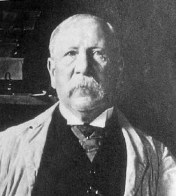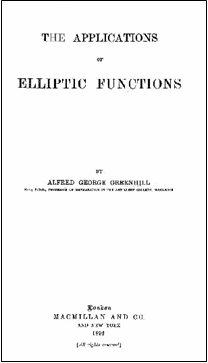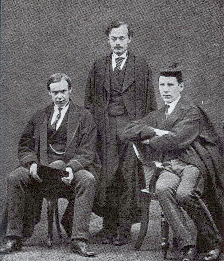 The website is in construction. New files will be uploaded as soon as they are available.
The website is in construction. New files will be uploaded as soon as they are available.
ALFRED GEORGE GREENHILL
London 1847 - London 1927

- Brief scientific biography
- Contributions to Education
- Essential bibliography
- Publications on the teaching of mathematics
Brief scientific biography
Alfred George Greenhill was born in London on 29 November 1847. Educated at Christ's Hospital in London, he entered St. John's College, Cambridge, in 1866, graduating as second wrangler in 1870. After being elected to a fellowship at St. John's,

The majority of Greenhill's research was concerned with elliptic functions, or, more specifically, their applications in applied mathematics. He also contributed to the pure theory of elliptic functions, introducing useful simplifications in papers on "Complex multiplication" (1887) and "Pseudo-elliptic integrals" (1895). But, we are told, he always valued the practical applications more highly than the pure mathematics behind them, since "analysis was for him a means rather than an end" (LOVE 1928, 28). Indeed, he regarded a pure mathematical result "as of no real value until its correspondence with phenomena shown by some inorganic 'corpus vile' had been investigated" (NICHOLSON 1928-29, 418).To this end, he investigated the uses of elliptic functions in dynamics, hydrodynamics, electrostatics and elasticity theory, using them to treat problems such as the motion of a symmetrical top, various kinds of fluid motion, and the distortion of a circular wire under pressure. Towards the end of his career, he also supervised the computation of a set of elliptic function tables, which were published by the Smithsonian Institution in 1922.
Not surprisingly, considering his employment in a military institution, his research often had military applications, such as ballistics and aeronautics. For example, a paper on hydrodynamics from 1879 concerned the ballistic implications of the theory of the motion of a solid in a fluid:
"Greenhill applied this theory to give an account of the steadiness of flight conferred upon an elongated projectile by rifling. He determined the least angular velocity about its axis for which steady motion of a solid of revolution, moving in the direction of its axis, can be stable. ... This practical application of what was regarded as a recondite mathematical theory earned for him much renown at Woolwich." (LOVE 1928, 29)In the theory of elasticity, Greenhill's most important work was probably a paper from 1883 concerning the maximum length possible for an upright cylinder before it is bent under its own weight. Once he had solved the problem, Greenhill applied it to the computation of the greatest height to which a tree can grow, collecting data on the heights of particular trees to evaluate his result.
Throughout his long scientific career, Greenhill received many honours. He was elected a Fellow of the Royal Society in 1888, serving on its council in 1896 and 1897, and receiving its Royal Medal in 1906. He was also a prominent member of the London Mathematical Society, acting as its president from 1890-92 and receiving its De Morgan Medal in 1902. He was also known and respected overseas, being on friendly terms with several continental mathematicians, most notably Felix Klein. A corresponding member of the Académie des Sciences and an honorary foreign member of the Academia dei Lincei, Greenhill was also the first British scholar to give a plenary address at an International Congress of Mathematicians, which he did at Heidelberg in 1904. Finally, on his retirement from the Artillery College, he was knighted by King Edward VII in 1908.
He continued to work on mathematics during his retirement, publishing papers and attending conferences, including a meeting of the British Association for the Advancement of Science in Canada in 1925. But his health gradually declined throughout the 1920s, and he died on 10 February 1927.
Contributions to Education
To British mathematics students, Greenhill would have been known principally for his university-level textbooks.

Greenhill (right), pictured in 1870 with fellow Cambridge graduates, E. L. Levett (left) and Richard Pendlebury
"a still more original book was his Treatise on Hydrostatics (1894). In this he developed a thoroughly physical presentation of the subject, using such mathematics, whether elementary or not, as might be needed, and constructing examples from data gleaned from such technical publications as the Transactions of the Institute of Naval Architects." (LOVE 1928, 30-31)In his later years, Greenhill's style of applied mathematics became increasingly unfashionable when compared to the new rigorous approach to pure mathematics, as practiced by such early 20th-century British mathematicians as Hardy and Littlewood, which he disparagingly referred to as "the morbid pathology of the mathematical function" (LOVE 1928, 31). His old-fashioned views were accentuated by such a high admiration of Newton's Principia, that, he said, "I should prefer to see the whole three books prescribed in the Cambridge course, to be studied in the original Latin" (GREENHILL 1892-93, 13). However, Love conjectures that "in making such assertions he was not more than half serious" (LOVE 1928, 31).
On his retirement from his Woolwich professorship, Greenhill devoted his mathematical activities more explicitly to matters concerning pedagogy. At the 1908 International Congress of Mathematicians at Rome, he was appointed one of the founding three members of ICMI, the other two being Klein and Fehr (LEHTO 1998, 13; HOWSON 1982, 164). He served as vice-president of the Commission until 1920. Interestingly, when Greenhill requested funding from the British government, "an application to our Board of Education for patronage met a very curt refusal -- No funds!" (GREENHILL 1913-14, 259).
Financial and organisational help was eventually provided by another body with which Greenhill was involved: the Mathematical Association, Britain's oldest professional society for mathematics teachers. Greenhill took an active interest in its affairs and contributed a number of mathematical articles to its journal, The Mathematical Gazette. He also served as the Association's president from 1913-14, delivering a valedictory address on "The uses of mathematics", a rambling miscellany of no fixed theme which can only be described as eccentric.
But despite his unconventionality, Greenhill was apparently a successful and highly respected teacher. "In all his work, as writer, as examiner, as teacher, with a ruthless insistence on reality, he combined such remorseless pertinacity and such painstaking thoroughness as should make his memory an inspiration to future generations of mathematicians" (LOVE 1928, 32). Indeed, as one of his former students reports, "Greenhill was loved by his old pupils to a degree which few Professors can have enjoyed" (NICHOLSON 1928-29, 417).
Essential bibliography
A. G. GREENHILL 1886, Differential and integral calculus, with applications, London, Macmillan. 2nd edition,1891. 3rd edition, 1896.
A. G. GREENHILL 1892, The applications of elliptic functions, London, Macmillan.
A. G. GREENHILL 1892-93, Collaboration in mathematics, Proceedings of the London Mathematical Society, 24, 5-16.
A. G. GREENHILL 1894, A treatise on hydrostatics, London, Macmillan.
A. G. GREENHILL 1912, The dynamics of mechanical flight, London, Constable.
A. G. HOWSON 1982, A history of mathematics education in England, Cambridge, University Press.
O. LEHTO 1998, Mathematics without borders: A history of the International Mathematical Union, New York, Springer.
A. E. H. LOVE 1928, Alfred George Greenhill, Journal of the London Mathematical Society, 3, 27-32.
J. W. NICHOLSON 1928-29, Sir George Greenhill, The Mathematical Gazette, 14, 417-420.
Publications on the teaching of mathematics
A. G. GREENHILL 1911-12, Presidential address to the London branch of the Mathematical Association, The Mathematical Gazette, 6, 104-108.
A. G. GREENHILL 1913-14, The use of mathematics, The Mathematical Gazette, 7, 253-259.
Author
Adrian Rice
Randolph-Macon College, Ashland, Virginia
arice4@rmc.edu
